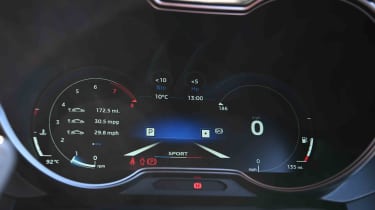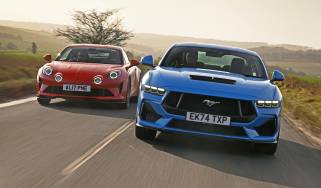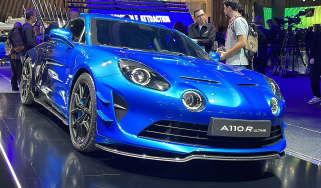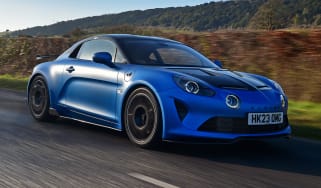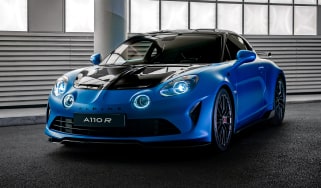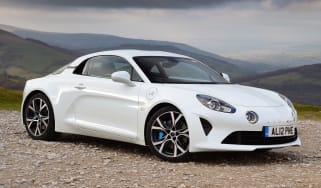Alpine A110 review
Two-seater Alpine A110 offers a real sense of occasion as well as great dynamics

Is the Alpine A110 a good car?
The relaunch of Alpine as a brand was always going to be exciting. Reviving a manufacturer steeped in motorsport excellence and known for producing lightweight sports cars was a stroke of genius by Renault, and with many of Renaultsport’s engineers – responsible for some of the greatest hot hatchbacks of the last few decades – raring to go after the demise of hot Clios and Meganes, we were looking forward to the result.
And it sure didn’t disappoint. The A110 instantly won us over with its fabulous driving experience; that motorsport-like double-wishbone suspension mated to a lightweight chassis makes it feel like it was designed specifically for UK roads. Over the years, the formula has been mildly tweaked and new variants have been launched – as has an endless stream of special editions – but the original formula has been maintained.
| Key specs | |
| Fuel type | Petrol |
| Body style | Two-door coupe |
| Powertrain | 1.8-litre turbo, seven-speed auto, rear-wheel drive |
| Safety | Untested by Euro NCAP |
| Warranty | Three years/60,000 miles |
How much does the Alpine A110 cost?
When it was originally launched in 2018, the Alpine A110 started from a little under £47,000, but today the line-up kicks off at around £54,500. That gets you behind the wheel of the standard A110, while the A110 GT is around £65,500, the A110 S is £67,500 and the flagship of the range is the A110 R Turini, which is a whopping £92,000.
Used - available now
That’s a lot of cash, but you’re getting a very pretty two-seater coupe for the money, while the lightweight motorsport-inspired underpinnings mean the A110 delivers engaging handling, whichever model you choose. Power for all versions comes from a 1.8-litre turbocharged four-cylinder engine, which might not sound very big, but it’s sourced from the last Renaultsport Megane and comes with 249bhp in standard guise, or 298bhp for the rest of the line-up. All models feature a seven-speed twin-clutch auto with steering wheel paddleshifters, and rear-wheel drive is the only configuration on offer.
The basic A110 still has a long kit list, with climate control, LED lights, keyless starting, heated Sabelt racing seats finished in leather and microfibre cloth, a sports exhaust, drive mode selector, a touchscreen infotainment system and 18-inch alloy wheels.
As well as getting a bit more power, the A110 GT adds more luxury kit. There’s a different wheel design (plus the option of adding lighter forged alloys) and a revised lighting treatment, brown leather seats (which can be specified in black at no extra cost), a Focal sound system, auto lights and wipers, an active exhaust and more microfibre interior trim.
The A110 S comes with a sportier chassis set-up, forged alloy wheels as standard (a titanium finish available as an option, as is a different wheel design, still 18 inches), the Sabelt seats feature orange stitching, and racing bucket seats are available as an option. The S gets the same Focal sound system as the GT, while there is wider scope for personalisation, with the option of a contrasting roof colour, or a carbon-fibre roof insert, a rear wing kit and the option to add an Akrapovic exhaust system to deliver a fruitier sound.
The A110 R is a hardcore motorsport-inspired, track-focused variant, hence the steep price – think of it as Alpine’s equivalent of a Porsche Cayman GT4. It doesn’t have any more power than the A110 S, but features lots of lightweight carbon fibre outside (including the roof and bonnet, plus the rear window), lighter wheels and one-piece Sabelt bucket seats with six-point harnesses.
As well as the standard A110, GT and S models, Alpine has produced a number of special editions with different paint, wheels and specifications, ranging from the subtle to the ostentatious.
Alpine history
French sports car maker Alpine was founded by Jean Redele in 1955 after he spent time modifying Renault cars to make them more competitive in motorsport. From the start, the company built compact sports cars based on Renault running gear, often with lightweight fibreglass bodies to help extract the most performance out of modest petrol engines.
Alpine’s first car was the A106, which had a name based on Renault’s in-house coding for the 4CV on which the coupe was based. From there, Alpine went on to create the A108 and then the A110, which achieved many successes in rallying.
In tandem with rallying, Alpine also competed at the Le Mans 24 Hours, first in the smaller classes with streamlined sports cars powered by modest Renault production car engines, and later with the A442, which won the race outright in 1978.
Alpine’s connections with Renault have been there since the start, and the sports car maker was absorbed into the French giant in 1973. Alpines were produced until 1995, when Renaultsport took over, but Alpine made a comeback in 2017 with the new A110. Since then, Alpine has returned to motorsport, with entries in Formula One and sports car racing.
Engines, performance & drive
On paper, some buyers might look at the 1.8-litre capacity of the Alpine’s four-cylinder engine and be left underwhelmed. But it comes from good stock, because it’s essentially the same unit that was fitted to the final-generation Renaultsport Megane – a car that was never criticised for lacking straight-line speed. In base spec, there’s 249bhp on tap, climbing to 296bhp for the rest of the range.
With that engine bolted behind the driver in a car that weighs just 1,102kg – around 200kg less than even the lightest Renault Megane RS Trophy R – in any of its forms, performance isn’t in short supply. The base A110 can dash from 0-62mph in 4.5 seconds, and the more potent (and lighter) R model shaves half a second off that.
But it’s the way in which it delivers that power that adds to the excitement. With so little weight to move around, the Alpine always feels eager to surge forward with even a gentle tickle of the throttle. As the engine reaches its boost, the car flies towards the horizon in a way that feels every bit as dramatic as its rivals. While the noise from a four-cylinder turbo is never going to be as exciting as a Porsche Cayman’s flat six or a Mustang’s V8, it’s among the better examples of the breed – suitably rorty on acceleration without going over the top with childish pops and bangs from the exhaust, offering just a little turbo whoosh to add more character.
When the A110 was announced, we were disappointed to discover that there would be no manual gearbox option. However, we’ve long dismissed that as an issue, because the dual-clutch transmission used here is superb. Shifts are responsive both up and down the ratios, and it’s also very smooth and easy to live with at parking speeds, with no unnecessary sharpness or jerkiness.
Few cars deliver the purity and precision of the Alpine A110, whether the road is challenging or not. It’s a truly superb driver’s car, yet remains one that’s approachable, too. Around town it takes barely 100 metres of driving the A110 to understand its strengths. The car moves off from a standstill feeling like there’s no inertia whatsoever, and the steering, which is light, feels wonderfully precise. Its compact dimensions make it easy to place on the road, the turning circle is good, and a composed ride means it’s also perfectly happy gently pottering around town.
Driving the A110 solely on urban trips would be missing out on what it’s truly capable of, however – it’s on a twisty B-road where it really shows its mettle. There are few cars better suited to a UK back road; those compact dimensions once again come into play, but it’s the suspension’s ability to soak up bumps that steals the show. This enables the Alpine to flow along a tricky section of tarmac better than any of its closest rivals, remaining unfazed by mid-corner bumps. The lack of mass has allowed Alpine’s engineers to soften the suspension just enough to allow a touch of body roll – a useful indicator for the driver as to how much the car is loading up through the turns – while keeping things neatly under control when the road really gets challenging.
If anything, it’s the base A110 that feels best suited to UK roads; the firmer S and R variants stiffen things up, which makes them more focused on smooth surfaces or tracks, but prevents them from riding quite so sweetly as the entry-level version elsewhere.
That light steering is also loaded with feedback, and can point the car towards an apex with barely a flick of the wrist. The balance is wonderful, grip is strong and the brakes manage to give plenty of confidence even after repeated, heavy use.
One of the small compromises of the A110’s light weight is that certain creature comforts are used more sparingly. Soundproofing is one such luxury that you’ll struggle to find. Compared with a Ford Mustang or a BMW M2, the A110 isn’t as peaceful inside at motorway speeds, but road and wind noise aren’t much worse than you get in a Porsche Cayman. That composed ride also comes into its own here, because this is an impressively comfortable cruiser.
At the top of the range sits the A110 R. Think of it as the GT3 to the standard Porsche 911 range; it removes weight, largely through the use of carbon-fibre parts extending as far as even the wheels, to add more focus.
While it’s firmer-riding than the base A110, there’s an extra layer of sophistication built in. So while it’s a bit firmer to use every day, once it’s on the right road, it’s transformed into a mind-blowingly sharp performance car. It’s expensive, but if you can afford it, it’s definitely worth the extra.
| Model | Power | 0-62mph | Top speed |
| A110 | 249bhp | 4.5 seconds | 155mph |
| A110 S | 296bhp | 4.2 seconds | 162mph |
| A110 R | 296bhp | 4.0 seconds | 177mph |
MPG, emissions & running costs
With so little weight to lug around, the engine really doesn’t need to work very hard in everyday driving. As a result, the A110 is impressively kind on your wallet at the fuel pumps – especially by the usual standards of a high-performance car.
When we ran an A110 on our long-term test fleet, we averaged 34.8mpg over the course of 12,000 miles. Lengthy motorway journeys can see that figure climb beyond 40mpg. There will be many drivers who will consider taking an A110 on a track day, and that light weight has its benefits there, too, because compared with a heavier rival like a BMW M2, the Alpine will be much kinder on its tyres and brakes.
Low fuel usage translates into modest CO2 emissions, which means, for fleet users, an A110 is cheaper to tax than pretty much any of its rivals – although a sports car with a price tag north of £50,000 still won’t be a cheap option.
A price hike in VED from April 2025 means the A110’s first-year costs climb to £1,360, but that’s still £2,000 less than the comparable figures for either a BMW M2 or a Porsche Cayman, and over £4,000 cheaper than a Ford Mustang GT. Depending on variant, the A110’s insurance groups range from 47 to 50, which is similar to rivals.
The A110 resists depreciation admirably, regardless of which variant you choose. After three years or 36,000 miles, the estimated figures range from the A110 S clinging onto just under 57 per cent of its original value, up to a residual value of almost 60 per cent for the base A110.
| Model | MPG | CO2 | Insurance group |
| A110 | 42.2mpg | 152g/km | 47 |
| A110 S | 40.9mpg | 156g/km | 49 |
| A110 R | 41.5mpg | 156g/km | 50 |
Design, interior & technology
It’s a little more sparse inside than some of its rivals, but that’s one very small compromise you have to pay for the A110’s light weight, which forms such a significant part of the driving experience.
Those stepping out of a BMW M2 or even a Porsche Cayman will no doubt find the A110’s cabin a little spartan – but that’s kind of the point when you consider the seventies rally car it pays tribute to.
It has all of the features you need, with just one or two small luxuries thrown in. There are plenty of examples of Renault parts bin sharing here; the climate control panel is lifted from a Mk1 Renault Captur and there are lots of other buttons familiar to the brand’s cheaper models. But at least all of those controls are operated with physical switches, so they’re rather easier to use than touchscreens. The neat bank of toggle switches below the screen and array of buttons for the gear selector add design flair.
You won’t find many soft-touch plastics inside the A110’s cabin, but it manages to make the most of its lightweight approach without feeling cheap and nasty. The steering wheel is nice to hold and is neatly trimmed in Alcantara in all but the base model. The steering wheel-mounted gear paddles feel solid and have a more pleasing action than in most rivals.
Sat-nav, stereo and infotainment
In a car where simplicity is one of its key selling points, the A110 isn’t loaded with tech. However, Alpine’s Telemetrics system can help to coach its owner to help them get the most out of the car. Standard on the S and the R and optional on the entry-level model, Alpine-Telemetrics allows the driver to monitor the car’s vital statistics in real time.
It’s fair to say that the seven-inch display in the A110 isn’t exactly the most advanced of its type – indeed, the basic interface is similar to that seen on previous generations of Renault’s small cars. Don’t expect glitzy graphics and instantaneous loading times here, then, because everything feels a bit clunky. Fortunately, it’s possible to hook up a smartphone via Android Auto or Apple CarPlay, so things are much better if you leave your own device to take care of navigation and music.
Boot space, comfort & practicality
A two-seat performance car is never going to deliver limo-like cabin space, but the Alpine’s compact luggage areas are just about adequate for a few bags of soft luggage – that’s as good as it gets.
The seats are height-adjustable, but not via a lever – you’ll need to remove and refit a couple of bolts to relocate the seat into a higher or lower position, so it’s not something you can do quickly between drivers.
Regardless of where it’s positioned, your brain is initially tricked into thinking that you’re sitting a little high; but this is because the base of the windscreen sits so low. It’s a feeling that the A110 has in common with modern McLarens and the original Honda NSX, and the benefit is that you get a brilliant view of the road ahead. Storage is very limited, however, with a small net and shallow door pockets about the full extent of the options for holding items in the cabin.
Long weekends away in the Alpine will need some investment in soft luggage and fairly light packing, because the 90-litre boot isn’t just small, the opening is tiny, too. Fortunately there’s a second boot up front, which at 100 litres is a little larger. The front boot is the place to store the weekly shop, while the back is for takeaway meals; due to the exhaust’s proximity to the rear compartment, it tends to warm up once the engine is fully up to temperature.
| Dimensions | |
| Length | 4,510mm |
| Width | 1,865mm |
| Height | 1,650mm |
| Number of seats | Two |
| Boot space | 100 litres front, 90 litres rear |
Safety & reliability
Alpine didn’t feature in our 2024 Driver Power customer survey, although the Renault Group’s results overall were, it’s fair to say, a bit mixed. While Renault itself as a brand finished a disappointing 28th out of 32, the Dacia Duster, which is built using mostly parts from Renault models, proved to be the most satisfying car to own in the UK according to its owners.
There isn’t a huge amount of safety tech on offer in the A110, but you do get stability control, emergency brake assist, hill-start assist and a couple of airbags. The A110 is also offered with a three-year/60,000-mile warranty, which is the industry standard.
Alpine’s dealer network isn’t as widespread as those of Ford, BMW or Porsche, so keeping up scheduled maintenance could be more of a hassle than rivals, depending on how close you live to one of the brand’s 16 UK locations.
Alpine A110 alternatives
The sports car market isn’t as big as it once was, but there are options available from rivals. The most obvious is the Porsche 718 Cayman, which also comes with a four-cylinder engine, although we prefer the flat-six that’s offered higher up in the line-up. And if you want the wind in your hair, then the Porsche 718 Boxster is available.
The Lotus Emira offers a similar lightweight solution and comes with four-cylinder turbo or V6 power, while the Toyota GR86 and Toyota Supra are priced similarly to the A110. A left-field choice, but one that harks back to sports cars of old is the Ford Mustang. It’s a four-seat coupe with a big V8 up front, but it’s similarly priced and is surprisingly agile in its handling. Finally, the BMW M2 and BMW 2 Series Coupe offer sweet rear-drive handling at a similar price point.
Alpine A110 GT long-term test
Contributing editor, Steve Sutcliffe, certainly enjoyed the driving experience over seven months and nearly 8,000 miles behind the wheel of a GT trim Alpine A110, but it certainly wasn’t trouble-free.
Steve experienced some niggles during his ownership, from the sat-nav screen going blank just at the end of his journey when he needed directions, the odd interior rattle and squeak, plus some erratic behaviour from the gearbox as the car approached its 12,000-mile service. Happily, all the mechanical and interior trim issues were taken care of, at which point, Steve seriously considered buying an A110.
Frequently Asked Questions
While Alpine quotes fuel economy in the low 40s for all models in the range, when we ran an A110, we saw figures closer to 35mpg. That’s still pretty impressive for a sports car that delivers entertaining handling that urges you to press on when you can.








